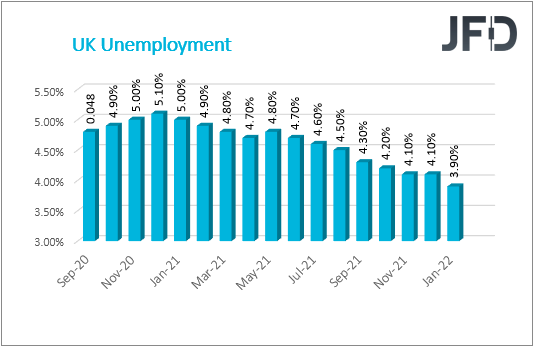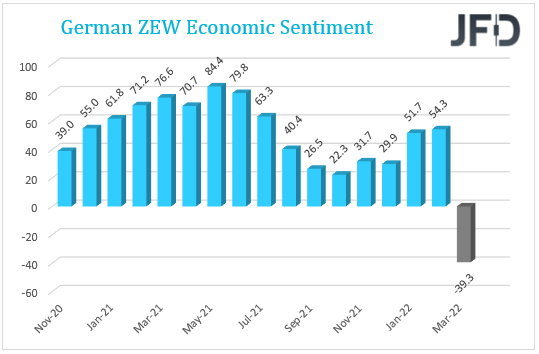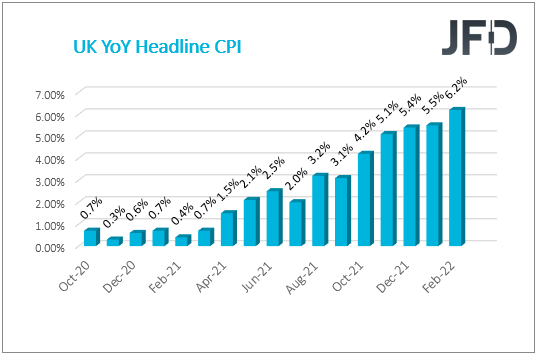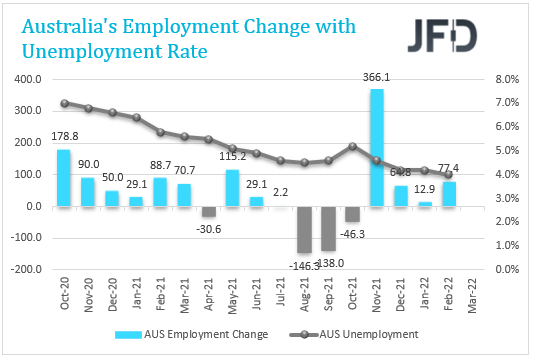We have an eventful week ahead of us, as several countries will be delivering their economic figures. The U.S. and the U.K. will be throwing out their inflation numbers. However, the spotlight will fall on the RBNZ, BoC, and ECB and their interest rate decisions. Most Western bourses will be closed on Friday due to the Easter celebration.
Monday will be a relatively quiet day on the economic calendar. The only worthwhile events will be out of the United Kingdom. The country delivered its MoM and YoY GDP numbers for the month of February. Both readings were expected to decline, where the MoM number was forecasted to go from +0.8% to +0.3%, and the YoY one was expected to move from adjusted +10.5% to +9.5%.
The actual figures came out at +0.1 and +9.5%, respectively. Also, the United Kingdom delivered the industrial and manufacturing production figures for February. Both Mom readings failed to meet their expectations and fell into negative territory.
Tuesday will kick off with Japan releasing its March producer price index on an MoM and YoY basis. The forecast is for the MoM figure to improve from +0.8% to +0.9% and for the YoY number to remain the same, at +9.3%. We do not expect the Japanese yen to move much on this news, as JPY could stay vulnerable to the broader market sentiment.
From the United Kingdom, we will receive the February average hourly earnings numbers, both including and excluding bonuses. Both figures are expected to grow slightly, the excluding bonus one – from +3.8% to +4.0% and the including bonus one – from +4.8% to +5.4%.
Also, we will get a closer look at where the British unemployment rate stands. The current forecast is for the number to remain the same, at 3.9%.
At the same time, Germany will be releasing its final MoM and YoY inflation numbers for March. The current expectation is for both numbers to grow, where the MoM one is believed to have risen from +0.9% to +2.5%, and the YoY one is forecasted to have grown from +5.1% to +7.3%. The ECB continues to monitor the situation carefully.
In addition to the CPI figures, Germany will also deliver the ZEW economic sentiment number for April, which is believed to have dropped even lower, from -39.3 to -48.0. The eurozone ZEW figure will also be released. However, there is no available forecast for it. If all these economic indicators fall below their previous readings, the euro may continue drifting south against its major counterparts.
The U.S. core and headline inflation numbers on an MoM and YoY basis will also hit the spotlight, as they are expected to continue growing. For example, the core YoY one is forecasted to rise from +6.4% to +6.6%, and the YoY one is expected to grow from +7.9% to +8.5%.
If the actual numbers show up as forecasted or above, this may continue to apply pressure on the stock market, as investors would expect the Fed to stay on the same path of raising rates more drastically through this year.
On Wednesday, during the Asian trading day, the Reserve Bank of New Zealand will deliver its official cash rate (OCR) decision, together with the monetary policy statement. From October 2021, the RBNZ has gradually raised rates by 25 bps during every one of their announcements.
The current expectation is that the committee will continue with the same vector and raise the rate by another 25 bps, bringing it to +1.25%. New Zealand is also trying to battle its fast-rising inflation, which came out at +5.9% for Q4 2021.
The current inflation target for RBNZ is between +1.0% and 3.0% over the medium term, with the focus on keeping the number near +2.0%. NZD might strengthen slightly after the news. However, the currency could stay more vulnerable to the commodity sector.

The European morning will start with the United Kingdom releasing its core and headline inflation readings, PPI input, and output numbers, followed by retail price index figures. All the numbers will be for March.
The core and headline MoM readings are expected to go down slightly; however, the core and headline YoY figures are expected to grow, where the core one is forecasted to go from +5.2% to +5.4%, and the headline one to rise from +6.2% to +6.7%. The current inflation in the U.K. is already three times higher than the CPI target of the Bank of England, which is set at 2.0%.
British core and headline PPI input and output figures are expected to grow by a bit, together with the MoM and YoY retail prices. The MoM retail Price index is believed to have risen from +0.8% to +0.9% and the YoY one is expected to go from +8.2% to +8.7%.
From the U.S. we will get the core and headline PPI figures for March, on an MoM and YoY basis. All the numbers are expected to grow slightly. Also, the U.S. will deliver its crude oil inventories, which currently don’t have any forecast available. If the figure shows up above the +2.421mln threshold, this could mean that the supply had increased, which may lead to a slight drop in the price of crude.
However, probably the main event on Wednesday’s economic calendar will be the Bank of Canada’s interest rate decision. The current expectation is for the rate to rise further, but this time twice as fast as during the previous announcement. During the last decision at the beginning of March, the rate was lifted by 25 bps, going from +.25% to +0.5%.
This time, the forecast is that the rate will rise by 50 bps, potentially bringing it to +1.00%. This may help strengthen a bit the Canadian dollar against some of its major counterparts. However, the hike might already be priced in by market participants, meaning that CAD could remain affected mainly by the oil price.

The economic calendar will start with Australia's employment numbers for March on Thursday. The unemployment rate is believed to have dropped a bit, from +4.0% to +3.9%. The participation rate is forecasted to improve by a fraction, going from 66.4% to 66.5%, whereas the employment change reading is expected to decline from the previous 77.4k to 40.0k.
If the actual numbers show up below their initial forecasts, the AUD could weaken slightly against some of its major counterparts.

But the spotlight will most likely fall on the ECB’s interest rate decision. Currently, the bank is not prepared to raise the rates yet. As mentioned in the ECB's account of the monetary policy meeting, the bank believes that the conditions for lifting rates were fulfilled or are ready to be fulfilled.
However, the committee did mention in their last meeting that the asset purchase program could end sometime in Q3 of 2022 if the inflation outlook does not weaken. The rates would be raised only after the asset purchase program had ended. The euro might not move much on the rate decision. However, we could see some fluctuation during the ECB press conference, which will take place around 45 minutes later.
From the U.S. we will receive the March MoM and YoY retail sales figures. The MoM number is expected to grow from +0.3% to +0.6%, however, the YoY reading is forecasted to decline, from +17.6 to +11.0%.
The Western markets will be closed on Friday due to the Good Friday celebration in the Catholic world. However, there will be a few data sets that will be released during the day.
During the Asian morning, China will deliver its unemployment rate for March, which is expected to stay the same, at +5.5%. Canada will provide their March ADP employment change figure, for which there is no forecast available. From the U.S. we will get the industrial and manufacturing numbers for March, on a YoY basis. Both are forecasted to decline slightly.
